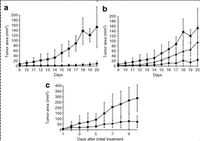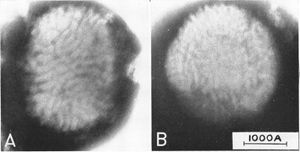Myxoma Virus: Difference between revisions
Darcypaulus (talk | contribs) |
Darcypaulus (talk | contribs) |
||
| Line 9: | Line 9: | ||
==Host-Symbiont Interaction == | ==Host-Symbiont Interaction == | ||
The myxoma virus is a parasitic symbiont to European rabbits. This relationship results in death of the European rabbit host. | The myxoma virus is a parasitic symbiont to European rabbits. This relationship results in death of the European rabbit host. The relationship between the European rabbit and the myxoma virus is important to microbiologists because it is one of the few natural infections in which virulence can be equated with lethality (9). | ||
==Molecular Insights into the Symbiosis== | ==Molecular Insights into the Symbiosis== | ||
Revision as of 01:06, 5 December 2011
Characteristics of the symbiont/pathogen
The myxoma genome is 161.8-kb long and makes up this double-stranded DNA virus. This enveloped virus is a member of the poxvirus family and is of the Leporipoxvirus genus (4).
Characteristics of the host
The host of the myxoma virus is European rabbits (Oryctolagus cuniculus). In this specific host, the myxoma virus causes a deadly infection called myxomatosis. The myxoma virus can infect other types of rabbits (including the American rabbit, Oryctolagus cuniculus), but only causes myxomatosis in European rabbits. The virus causes a tumor at the infection site of the rabbits and causes swelling of the adjacent connective tissues. Secondary myxoma tumors are found on other areas of infected rabbits (2).
Host-Symbiont Interaction
The myxoma virus is a parasitic symbiont to European rabbits. This relationship results in death of the European rabbit host. The relationship between the European rabbit and the myxoma virus is important to microbiologists because it is one of the few natural infections in which virulence can be equated with lethality (9).
Molecular Insights into the Symbiosis
The myxoma virus has a M-T7 protein that is specific in that it specifically binds rabbit IFN-gamma. By doing this, the M-T7 protein inhibits a regulatory cytokine that controls the host’s immune response to viral infections. Additionally, M11L genes prevent virus-induced apoptosis in infected rabbits. This extends the host range by inhibiting the apoptosis in the T lymphocytes that are infected (3).
Ecological and Evolutionary Aspects
The myxoma virus origionated in North and South America as it evolved in close association with sylvilagus (the cottontail rabbit). However, after 1950, the disease began to be used as a way to control rabbit populations in Europe, Australia, and Chile. Many different strands of the myxoma virus exist with virulances ranging from 50-95%. The more virulent strands were used as a way to control rabbit populations in these countries between 1950 and 1960 (5).
Recent Discoveries

Current research is investigating the effect of the myxoma virus on cancerous tumors in mice. The myxoma virus was injected multiple times into cancerous tumors of mice. The viral injections resulted in a decreased size of the tumors (specifically B16F10 tumors). Additionally, systemic treatment of mice inhibited the development of lung metastasis. Mice were exposed to B16F10LacZ cells that cause lung metastasis and the mice that were treated with the myxoma virus did not develop observable tumors (7).
Other current research deals with the myxoma virus’ ability to kill most human malignant glioma cell lines. This research also demonstrated that the myxoma virus is safe to administer to immunocompromised mice. It was found that the way in which the myxoma virus infected glioma cells was selective. This viral infection was long-lasting; lasting at least 42 days after initial infection (8).
References
1.) http://www.cdc.gov/eid/article/17/4/pdfs/10-1146.pdf Camus-Bouclainville, C., Gretillat, M., Py, R., Gelfi, J., Guérin, J., and Bertagnoli, S. "Genome Sequence of SG33 Strain and Recombination between Wild-Type and Vaccine Myxoma Viruses." Emerging infectious diseases. 2011; 17(4): 633-638.
4) http://www.sciencedirect.com/science/article/pii/S0042682299900016 Cameron, C., Hota-Mitchell, S., Chen, L., Barrett, J., Cao, J., Macaulay, C., Willer, D., Evans, D., and McFaddena, D. "The Complete DNA Sequence of Myxoma Virus." Virology. 1999; 264(2): 298-318.
Edited by Darcy Paulus, student of Grace Lim-Fong
This template is just a general guideline of how to design your site. You are not restricted to this format, so feel free to make changes to the headings and subheadings and to add or remove sections as appropriate.


